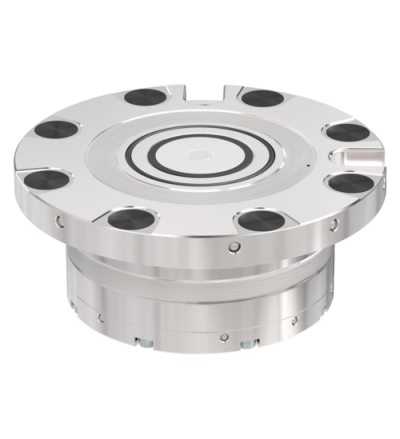
Zero-point clamping systems enhance the potential to automate multiple precision operation processes, whilst at the same time significantly reducing machine set up times by up to 90%. The use of this technology also makes it possible to link sequential processes across multiple machining cells which are equipped with the same clamping system. The workpiece carrier, incorporating the zero-point clamping system, accompanies the workpiece all the way through the production process, thus ensuring the ultimate in precision and cost efficiency.
The Right System for Your Production Processes
The modular SPN zero-point clamping system from Zimmer Group provides users with the right system for every application. The full range includes a standard version which incorporates all of the essential functions, such as unlocking and a PLUS connection. In addition, there is also an advanced version with an enhanced range of functionality suitable for automated production operations.
Both variants feature positive locking via clamping segments that are specially adapted to the pin contour. This creates an extremely rigid system that can absorb the highest forces with maximum repeat accuracy. The product range is extended through the use of different types of clamping plates, available in every size and in various configurations. To increase the protection of the particular zero-point clamping system and to prevent any intrusion of dirt and debris, there is also an optional automatic seal that reliably protects the pin opening.
The SPN zero-point clamping system features a repeatability of 0.005 mm due to its sophisticated design. Thanks to its very high clamping forces and consistent use of tempered stainless steel, the system provides a high-precision, torsion-resistant base that also stabilises parts that have a tendency to vibrate. Zimmer’s zero-point clamping system is able to absorb maximum forces with maximum repeatability. This is achieved through a sophisticated clamping principle that uses clamping segments for positive locking. In comparison to conventional systems where balls are in point contact.
The key features of the SPN Advanced Series include locking by means of clamping segments, PLUS connection, rustproof tempered stainless steel, two integrated rotation locks, integrated positioning check, pneumatic piston position sensing, integrated blow-out function, optional automatic seal, and two connection options.
Zimmer’s zero-point clamping system reduces errors during milling, turning, wire or die eroding, flat or cylindrical grinding, drilling, laser processing and inspection. The maintenance-free design also contributes to superior process reliability
Contact Details
Related Glossary Terms
- cylindrical grinding
cylindrical grinding
Grinding operation in which the workpiece is rotated around a fixed axis while the grinding wheel is fed into the outside surface in controlled relation to the axis of rotation. The workpiece is usually cylindrical, but it may be tapered or curvilinear in profile. See centerless grinding; grinding.
- flat ( screw flat)
flat ( screw flat)
Flat surface machined into the shank of a cutting tool for enhanced holding of the tool.
- gang cutting ( milling)
gang cutting ( milling)
Machining with several cutters mounted on a single arbor, generally for simultaneous cutting.
- grinding
grinding
Machining operation in which material is removed from the workpiece by a powered abrasive wheel, stone, belt, paste, sheet, compound, slurry, etc. Takes various forms: surface grinding (creates flat and/or squared surfaces); cylindrical grinding (for external cylindrical and tapered shapes, fillets, undercuts, etc.); centerless grinding; chamfering; thread and form grinding; tool and cutter grinding; offhand grinding; lapping and polishing (grinding with extremely fine grits to create ultrasmooth surfaces); honing; and disc grinding.
- milling
milling
Machining operation in which metal or other material is removed by applying power to a rotating cutter. In vertical milling, the cutting tool is mounted vertically on the spindle. In horizontal milling, the cutting tool is mounted horizontally, either directly on the spindle or on an arbor. Horizontal milling is further broken down into conventional milling, where the cutter rotates opposite the direction of feed, or “up” into the workpiece; and climb milling, where the cutter rotates in the direction of feed, or “down” into the workpiece. Milling operations include plane or surface milling, endmilling, facemilling, angle milling, form milling and profiling.
- turning
turning
Workpiece is held in a chuck, mounted on a face plate or secured between centers and rotated while a cutting tool, normally a single-point tool, is fed into it along its periphery or across its end or face. Takes the form of straight turning (cutting along the periphery of the workpiece); taper turning (creating a taper); step turning (turning different-size diameters on the same work); chamfering (beveling an edge or shoulder); facing (cutting on an end); turning threads (usually external but can be internal); roughing (high-volume metal removal); and finishing (final light cuts). Performed on lathes, turning centers, chucking machines, automatic screw machines and similar machines.
